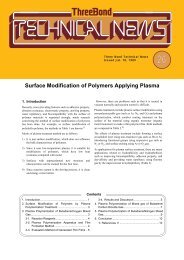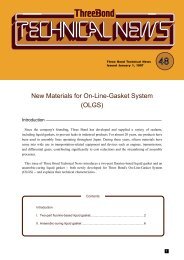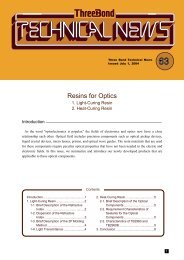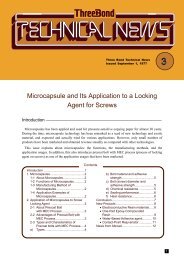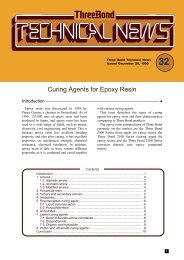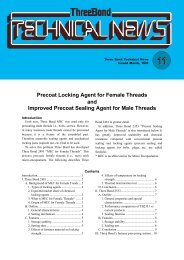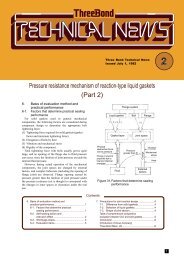New Light-Curing Instant Adhesives (ThreeBond 1771E, 1773E, and ...
New Light-Curing Instant Adhesives (ThreeBond 1771E, 1773E, and ...
New Light-Curing Instant Adhesives (ThreeBond 1771E, 1773E, and ...
Create successful ePaper yourself
Turn your PDF publications into a flip-book with our unique Google optimized e-Paper software.
2. Characteristics of light-curing instant adhesives2-1. <strong>Curing</strong> mechanismAs shown in Figure 1, a light-curing instantadhesive cures on irradiation by ultraviolet orvisible light, thanks to a photo polymerizationinitiator contained in the adhesive that decomposes<strong>and</strong> generates anion species (Nu - (nucleophile)),which then advances anion polymerization.Conventional light-curing resins include radicalpolymerization <strong>and</strong> cation polymerization typeresins. Much technological expertise hasaccumulated for radical polymerization type resinsin particular, resulting in a wide range of adhesivesbased on various resin combinations.Among these, anion types (including instantadhesives) that use anion species as polymerizationinitiators remain at the stage of basic research dueto their instability <strong>and</strong> h<strong>and</strong>ling difficulty. Onlyseveral studies have been reported to date. Kutal<strong>and</strong> Yamaguchi et al. (University of Georgia, 2))reported that 2-cyanoacrylic acid esters undergophoto-induced polymerization with the addition ofmetallocene derivatives such as benzoylferrocene.However, the report addresses only aspects such as:"increased viscosity" <strong>and</strong> "gelation," with nodiscussion of preservation stability. In short, thereport is not useful in advancing practical adhesiveapplications.Our research has shown that radical generatorssignificantly activate the reactivity of the aboveferrocene derivative. We have succeeded indeveloping light-curing instant adhesives withexcellent light-curing properties <strong>and</strong> goodpreservation stability through concurrent use ofadhesives <strong>and</strong> radical generators.As shown in Figure 3, light-curing instantadhesives are activated by light irradiation, whichcures excess adhesive that laps from the adherendsof bonded materials. Based on instant adhesives, theportion between the adherends cures instantly bymoisture curing, as do conventional instantadhesives.AdherendsUltraviolet or visible light<strong>Curing</strong> as a conventional instant adhesiveFigure 3: <strong>Curing</strong> mechanism<strong>Curing</strong> by opticalanion polymerization2-2. Characteristics of light-curing instantadhesives<strong>Light</strong>-curing instant adhesives combine both lightcuring <strong>and</strong> moisture curing. This combinationreduces bleaching effect <strong>and</strong> improves surfacecuring <strong>and</strong> filling bonding properties, <strong>and</strong> vastlyexp<strong>and</strong>s applications.Table 3 compares the characteristics oflight-curing instant adhesives, conventional instantadhesives, <strong>and</strong> typical light-curing resin.Table 3:Bonding of light-blocking materials<strong>Curing</strong> of excess portionsSurface curing propertyBleachingTemporary retaining jigsCharacteristics of light-curing instantadhesives<strong>Instant</strong>adhesivesNot required<strong>Light</strong>-curing instantadhesivesNot required<strong>Light</strong>-curingresinsRequired(1) Good bonding properties for light-blockingmaterialsAlthough transparent materials pose no problems,ordinary light-curing resins fail to cure when usedto bond light-blocking materials, as shown in Figure3, since the materials block light. In contrast,light-curing instant adhesives cure instantly viamoisture curing in the gaps between adherends.<strong>Light</strong>-curing instant adhesives are thus associatedwith lower incidence of curing failures thanlight-curing resins due to insufficient lightirradiation, even for transparent adherends.(2) Good surface curing of excess adhesivesprevents bleaching effectWhile conventional instant adhesives cureinstantly in the gaps between adherends, excessadhesive remaining as a liquid cures slowly,reacting with airborne moisture. This behavior isdue to an imbalance between the acid stabilizer <strong>and</strong>the alkaline initiator, with too much stabilizer forthe amount of moisture. Under these conditions, themonomer gas evaporates readily <strong>and</strong> promotesbleaching effect. In contrast, light-curing instantadhesives <strong>and</strong> light-curing resins require only lightto cure.It should be noted that oxygen inhibits the curingof light-curing resins that cure by radicalpolymerization, resulting in poor surface curingcharacteristics.(3) No fixing jig required at bonding4
While light-curing resins require fixing jigs untilexposed to light, most light-curing instant adhesiveshave the advantage of adhering when applied to theadherends, eliminating the need for fixing jigs. Thisextremely useful characteristic reduces labor costs<strong>and</strong> increases speed of production lines.2-3. Properties of light-curing instantadhesivesTable 4 shows the properties for <strong>ThreeBond</strong><strong>1771E</strong>, <strong>1773E</strong>, <strong>and</strong> 1776E.Table 4: Properties of light-curing instant adhesivesItems Unit TB<strong>1771E</strong> TB<strong>1773E</strong>TB1776EMonomerColor <strong>and</strong> appearanceMain componentViscosity--mPa sTransparent yellow liquid2-cyanoacrylic acid ester2 150 1000Linear expansion coefficient (0 -100 )10 6 /81-103 75-99 70-99Glass transition temperature Tg124 123 117St<strong>and</strong>ard curingconditionsUltraviolet curingVisible light curingkJ/m 2kJ/m 210 10 100.4 0.2 0.2PolymerDielectric breakdown voltageVolume resistivitykV/mmm27.0 26.0 25.85.4 10 13 5.9 10 13 5.4 10 13Surface resistivity1.2 10 13 5.9 10 12 1.2 10 13Dielectricconstant1MHz1MHz--3.27 2.69 2.904.05 3.34 3.61Dielectrictangent1MHz1MHz--0.0511 0.0529 0.05550.0522 0.0534 0.05482-4. Setting time <strong>and</strong> bonding strength oflight-curing instant adhesives<strong>Light</strong>-curing instant adhesives offer good bondingproperties for various substrates, similar toconventional instant adhesives. Table 5 shows anexample of the setting time <strong>and</strong> bonding strength oflight-curing instant adhesives. The tension shearingadhesive strength in the table is assessed in atension shear test after applying adhesives underconditions of 25°C <strong>and</strong> 50% humidity, followed by24 hours of curing. Except for materials (such asmetals) that are stronger than the adhesivesthemselves, most adherends exhibit material break(i.e., the material breaks before the adherends due tothe strength of the bond).Not shown in Table 5 is another advantage oflight-curing instant adhesives, this being thatnonpolar or highly crystalline resins, generallyregarded as difficult to bond, can bond strongly. Forexample, in combination with a primer (<strong>ThreeBond</strong>1797), light-curing instant adhesives create strongbonds when used with polyethylene, polypropylene,polyacetal, soft polyvynyl-chlorides including largeamounts of plasticizer, silicone rubber, <strong>and</strong> EPDMrubber.Figure 4 shows the curing speed for moisturecuring <strong>and</strong> light curing. As previously discussed,conventional instant adhesives are moisture-curingtype. However, moisture-curing adhesives do notcure fully when initially applied to adherends.Although bonding strength increases rapidly at first,to complete curing generally it requires 12 to 24hours at room temperature.<strong>Light</strong> irradiation allows a bond to attain finalstrength in approximately 10 seconds. Thus, theoptimal curing method is to temporarily fix the5
adherends by moisture curing, then to curecompletely by light irradiation.<strong>Instant</strong> adhesives generally function also asreactive "solvents" capable of dissolving thesurfaces of certain plastic materials, includingacrylic, polycarbonate, <strong>and</strong> ABS. Table 5 shows thatthe setting times for acrylic <strong>and</strong> polycarbonate arerelatively slow. This is due the mutual solution ofinstant adhesive <strong>and</strong> the plastic in the bonding area.Since they cure instantly, light-curing instantadhesives can prevent the dissolution of plasticsurfaces in such cases.Table 5: Setting time <strong>and</strong> bonding strength of light-curing instant adhesivesAdherendsPolycarbonateABS6-nylonPETAcrylicNBRPaper (woody paper)IronStainless steelAluminumCopperBrassSetting time (seconds)Tension shearing adhesive strength (MPa)TB<strong>1771E</strong> TB<strong>1773E</strong> TB1776E TB<strong>1771E</strong> TB<strong>1773E</strong> TB1776E12 15 20 11.0 (*) 8.9 (*) 9.1 (*)2 3 7 7.4 (*) 6.7 (*) 7.0 (*)5 7 15 7.1 (*) 7.1 (*) 7.2 (*)2 7 10 12.2 (*) 12.9 (*) 12.8 (*)15 25 45 5.8 (*) 8.4 (*) 8.5 (*)2 2 2 0.5 (*) 0.5 (*) 0.5 (*)5 15 30 - (*) - (*) - (*)3 5 10 15.1 15.9 16.83 7 15 11.9 11.3 12.43 10 20 10.6 11.2 11.43 7 20 11.5 13.5 11.53 5 15 9.2 10.3 10.9Test method: 3TS-220-04 (Setting time)(*) indicates material breaking.3TS-301-11 (Tension shearing adhesive strength) [Tension speed 10 mm/min]TB<strong>1771E</strong> TB<strong>1773E</strong> TB1776ETension shearing adhesive strength (MPa)1210864200 6 12 18 24Time (h)Tension shearing adhesive strength (MPa)1210864200 6 12 18 24Time (h)(Note) The light irradiation condition is 3.5 kJ/m 2 with a 4-kW high-pressure mercury-vapor lamp.Moisture curing is performed in shade at 25°C <strong>and</strong> 50% humidity.Figure 4: Comparison of curing speed for moisture curing <strong>and</strong> light curing (Adherends: polycarbonate)6
2-5. Applications of light-curing instantadhesives<strong>Light</strong>-curing instant adhesives offer a vast rangeof applications, including electric <strong>and</strong> electroniccomponents, fields in which conventional instantadhesives are not used, <strong>and</strong> precision components.They are used not just to create surface bondingwith various adherends, but for applicationsinvolving sealing, potting, <strong>and</strong> fixing. Additionally,since light-curing instant adhesives have theadvantage of curing at lower illumination thantypical light-curing resins, that is, since they curefaster, they should improve productivity in fastproduction lines. Major applications are listedbelow.(1) Electric, electronic, optical, <strong>and</strong> generalcomponents requiring non-bleaching properties(2) Fixing <strong>and</strong> bonding of supports around opticallenses(3) Fixing <strong>and</strong> bonding of various light-blockingadherends(4) Reinforcement of IC attachment(5) Bonding of fitting sections such as printer heads<strong>and</strong> bearings(6) Bonding of the fitting section of a drum motor<strong>and</strong> main shaft(7) Fixing <strong>and</strong> bonding of ornamental materials(8) Assembly of hypodermic needles <strong>and</strong> syringes(9) Creation of Braille characters <strong>and</strong> graphicsAdvancing miniaturization <strong>and</strong> driving to reduceweight has resulted in single components havingextremely fine structures. Even the portions thatcould conventionally be irradiated with sufficientlight, now the irradiation often causes problems. Insuch cases, light-curing instant adhesives that useboth light <strong>and</strong> moisture curing are effective inproviding reliable curing <strong>and</strong> bonding.With increasing miniaturization, printed circuitboards use less solder. But since bonding strengthmust be maintained, light-curing instant adhesivesare used to reinforce solder.For metal plated plastic components,conventional light-curing or anaerobic resinssometimes fail to bond the adherends. In some cases,light-curing instant adhesives are used, due to theireven broader bonding capabilities for a wide rangeof materials.Components such as hypodermic needles <strong>and</strong>syringes have direct effects upon the human body.Reliable complete bonding <strong>and</strong> curing is critical intheir assembly. <strong>Light</strong>-curing instant adhesives arealso used for Braille characters <strong>and</strong> graphics, sincethe surface curing of light-curing resins is relativelypoor due to oxygen-induced curing inhibition, asalready discussed, <strong>and</strong> touching incompletely curedportions with h<strong>and</strong> may result in skin irritations.<strong>Light</strong>-curing instant adhesives are not affected bycuring inhibition with oxygen. It can be said a betteradhesive.7
3. SummaryIn view of recent trends toward international green technologies, the effectiveness <strong>and</strong> benefits of light-curingtechnology (including reduced use of organic solvents) in the areas of environment <strong>and</strong> energy are beingrecognized once again. Adding light curing properties overcomes the disadvantages of instant adhesives. Therange of potential applications for light-curing adhesives continues to exp<strong>and</strong> rapidly.We plan to pursue the commercialization of shock-resistant <strong>and</strong> highly peel-resistant products, with the goal ofovercoming the remaining disadvantages of the materials discussed, thereby exploiting new applications <strong>and</strong> newmarkets.Masakazu MotokiIndustrial Materials Development DivisionDevelopment DepartmentResearch LaboratoryThree Bond Co., Ltd.1456 Hazama-cho, Hachioji-shi, Tokyo 193-8533, JapanTel: 81-426-61-13338



